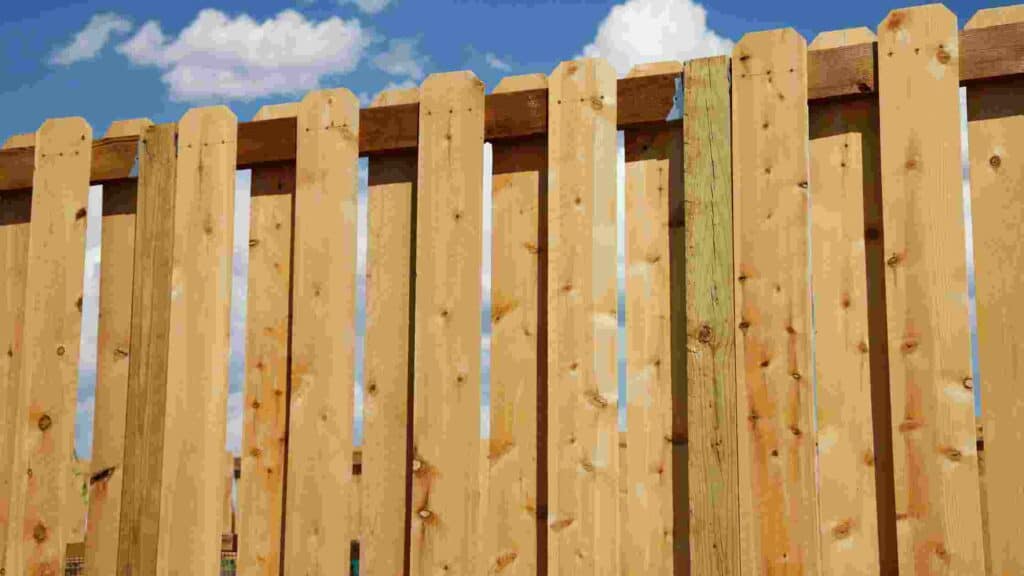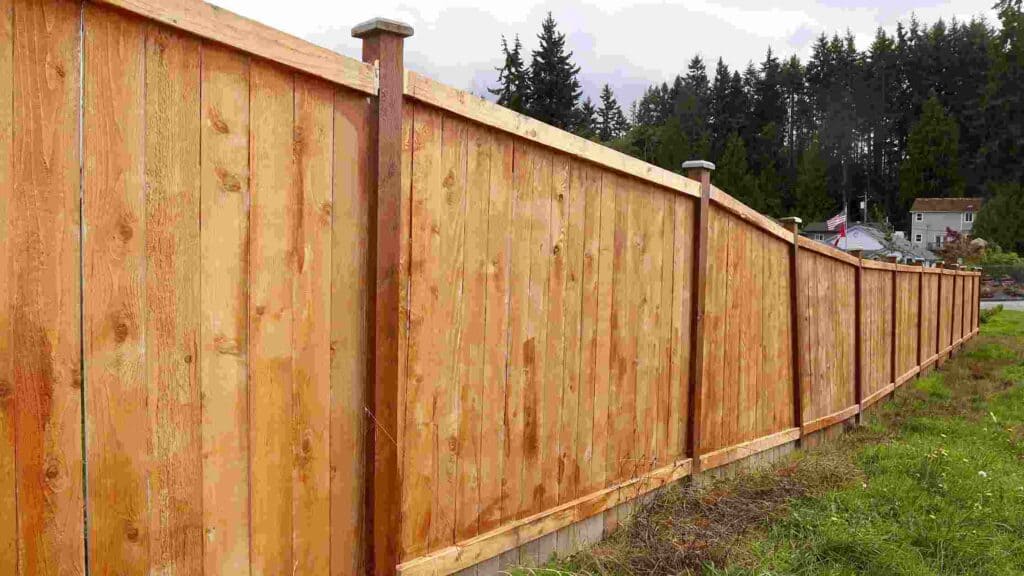Cedar fences are a popular choice across America, and it’s no surprise why. But just how long does a cedar fence last, and what can you do to ensure it stays in top-notch condition?
These fences offer a winning combination of durability, charm, and longevity that makes them stand out among other wood fence options.
Let’s delve into some useful tips to keep your cedar fence looking great for years to come!
How Long Does A Cedar Fence Last?
Generally, you can expect a well-maintained cedar fence to last anywhere between 15 to 30 years, making it a worthy investment for your property.
Cedar’s innate qualities make it a remarkable choice for outdoor structures, including fences. Its slow deterioration rate, resistance to decay, and ability to withstand weather conditions are all factors contributing to its extended lifespan.
1. Regular Resealing
Maintaining your fence’s protective barrier is crucial.
Plan to reseal your cedar fence every 3 to 5 years to keep it in top shape. This routine maintenance not only safeguards against rot but also ensures the fence retains its natural beauty.
2. Protect Against Moisture

One of the primary enemies of any wood fence is moisture.
To shield your cedar fence from the harsh effects of weather, it’s essential to apply a waterproofing sealer. This process helps prevent splintering and cracking, and a sealer with built-in UV protection adds an extra layer of defense against the sun’s rays during hot weather.
Pay attention to the surroundings of your fence to minimize moisture-related issues. Ensure that sprinklers and irrigation systems are not spraying water directly onto the fence, as excess moisture can lead to decay.
Also, if your fence posts sit in damp soil, consider treating them before installation and use a concrete or gravel filler to keep moisture at bay.
3. Proper Drainage
Ensure your fence has proper drainage so that water doesn’t accumulate near the posts. Standing water can be detrimental to your fence’s longevity, so it’s crucial to address any drainage issues promptly.
4. Clear The Area
Insects can be a bother to your fence’s well-being, so it’s essential to keep the area around the fence clear of debris and piles of leaves that could become a cozy home for pests.
Trim back any vines and bushes that are clinging to the fence, as they can trap moisture and damage the wood over time.
5. Keep it Clean
Cleaning your cedar fence is essential to keep it looking fresh and free from mildew or mold. An annual cleaning should suffice.
Remove dirt, mildew, and moss by scrubbing with a bleach solution or mild detergent. Rinse the fence thoroughly afterward.
Recoating your fence with a water-repellant protective coating after cleaning will help maintain its resilience against the elements.
6. Routine Fence Inspection
Regularly inspect your fence for signs of damage or rot. Address leaning sections, tighten loose screws, and replace any broken boards promptly.
Keeping your fence in good repair will extend its life and maintain its structural integrity.
Cedar vs Pine Fences: Which Is Better?
Cedar and pine are two of the most popular materials for building fences, each with its own set of characteristics.
Let’s compare them to help you make an informed decision:
1. Cost
Pine Fence Cost
Pine is the more budget-friendly option, typically ranging from $15 to $20 per linear foot.
Cedar Fence Cost
Cedar, while considered more attractive and durable, falls within the $25 to $35 per linear foot range.
Keep in mind that prices may vary based on your location and stock availability.
2. Appearance
Cedar boasts a warm and inviting red color that adds character to any property. On the other hand, pine has a much lighter hue, with light brown or creamy tones.
3. Aromatic Qualities
Cedar comes with a delightful fragrance that many people appreciate, adding a pleasant touch to outdoor spaces. Pine, however, has very little noticeable odor.
4. Climate Considerations
Cedar performs exceptionally well in dry climates, but in wet and humid regions, it may expand and face potential issues. On the other hand, pine fares better in such conditions.
5. Useful Life – How Long Does A Pine Fence Last?
In terms of longevity, cedar fences have the upper hand, lasting well over 20 years. Pine fences, while still respectable, usually last around 10 to 15 years.
Is Treating Your Cedar Fence Necessary For Lasting Longer?
You’ve just installed a stunning cedar wood fence, its vibrant red hue catching everyone’s eye. But what about maintaining that beauty over time?
The truth is, unless you treat your cedar fence, it will eventually fade to a muted gray color. The good news is that treating your fence can significantly extend its life compared to leaving it untreated.
Let’s dive into the details of cedar fence treatment and explore the various options available.
Does Staining A Cedar Fence Make It Last Longer?
Treating your cedar fence is not just about preserving its appearance, but also about increasing its overall longevity.
An untreated cedar fence may last around 20 years, which is impressive, but with proper treatment, you can extend its life to an astonishing 40 years. That’s double the fence’s lifespan, making it a smart investment for the long haul.
Options For Treating Your Cedar Fence

When it comes to treating your cedar fence, you have a few options to choose from:
1. Solid Color Stain
If you prefer an opaque color that still allows some of the cedar’s natural grain to show through, a solid color stain is the way to go. It provides excellent moisture and UV protection, ensuring your fence stays strong and beautiful.
2. Semi-Transparent Stain
Opting for a semi-transparent stain will give your fence a slightly weathered look, but less than what the bleaching oil achieves. Additionally, it offers protection from moisture, safeguarding the wood’s longevity.
3. Primer And Paint
For those who prioritize protection against light exposure, which can cause wood fences to deteriorate, using primer and paint is a wise choice. Remember to prime the fence before applying paint, as cedar’s large pores require proper preparation.
4. Bleaching Oil
Applying bleaching oil to your cedar fence will result in a naturally aged, weathered, and gray appearance. It also offers essential moisture protection. After about 3 to 6 months, you’ll see the beautiful transformation of your fence.
FAQs
1. How long does an untreated cedar fence last?
An untreated cedar fence can last around 10 to 15 years, depending on environmental factors.
2. Are cedar fences worth it?
Yes, cedar fences are worth it due to their natural beauty, durability, and resistance to decay.
3. How long will cedar fence last unstained?
An unstained cedar fence can last around 15 to 30 years, depending on maintenance and environmental conditions.
4. How long does a pressure-treated fence last?
A pressure-treated fence can last around 20 to 30 years or more, depending on the level of treatment and maintenance.
5. How long does a vinyl fence last?
A vinyl fence can last around 20 to 30 years, as it is resistant to rot, insects, and fading.
For more details, check out: how long does a vinyl fence last?
6. How long does a treated pine fence last?
A treated pine fence can last around 15 to 20 years, depending on the level of treatment and maintenance.
7. How long does a redwood fence last?
A redwood fence is highly durable and can last around 20 to 30 years or more with proper maintenance.
For in-depth information, check out: how long does a wood fence last?
Conclusion: How Long Will A Cedar Fence Last?
On average, a well-maintained cedar fence can last between 15 to 30 years.
Ultimately, the lifespan of your cedar fence depends on how well you maintain it over the years. Diligent inspections, repairs, and regular cleaning are essential to preserving its beauty and functionality.
Don’t forget to apply a protective coat to shield your fence from wear and tear, ensuring it remains an enduring and attractive addition to your property for decades to come!
